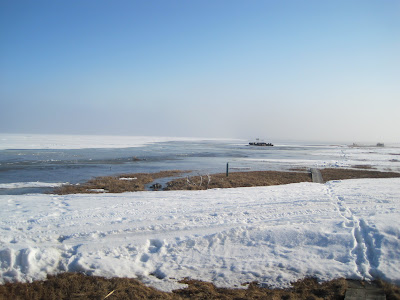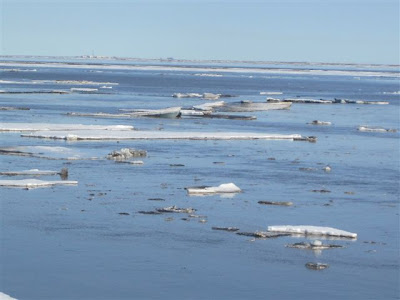I got drenched twice today. Usually water-haul day is fairly uneventful, other then the extra work it entails, but today....
For a bit of background to start out with...we have a very nice indoor water system with modern plumbing and running water to kitchen, bathrooms and laundry room. With two connected water tanks and capacity at about 800 gallons, we can go quite awhile on one filling of tanks.
In winter when it is below freezing, the chore of filling the tanks must be done by hand by carrying 5-gallon buckets of water into the house one or two at a time...very labor intensive, to say the least. Pictures below show our son Jay helping out with "water-haul" on one of his visits home:
 |
| From the lake |
 |
| Down the hall |
 |
| Into the tank |
Fresh water comes from our large lake near the house. The lake is frozen over, and a water hole is maintained. Usually water is dipped from the hole into big containers sitting on a sled behind a snowmachine and pulled up to the front door, then dipped out of the big container and carried into the house to the primary tank.
In the summer, the chore is considerably easier, since we can use a water pump and hoses to transport the water into the tank. It takes a few minutes to set up the pump and roll out the hoses, but only a fraction of that time to fill the tank, as the water pours out of the 2 inch hose at powerful pressure. It usually took a 3-person team to pump water, one running the pump out at the lake, one holding the hose at the tank, and one being the control person at the outside door. The person by the lake would start the pump and water flowing through the hose, the person at the tank would hold the hose and monitor the tank and yell out to the person in the doorway when the tank was nearly full, “CUT!” The person in the doorway would repeat the “CUT” with a “slice across the throat” motion to the person at the lake’s edge who was carefully watching for the signal to shut the pump off. This method only failed once when the pump person was distracted watching some birds at the critical moment. I wish I had a video of my mom (the inbetween person) running out toward the lake screaming, “CUT, CUT, CUT”, and waving her arms frantically to get the attention of the pump person. Meanwhile, I was frantically trying to figure out what to do with the “fire-hose” torrent of water shooting all over the bathroom and the tank overflowing. It took a few seconds for me to realize the best place for the hose was over the shower drain.
Now our indoor holding tanks need cleaning several times a year. Obviously, this is done just prior to a filling. I have been the designated maintenance person for this job for quite a few years, since I’ve been the smallest (capable of the job) person around for some time. Today was one of these days. I climbed down into the tank with scrub brush, small bucket, dipper, and sponge. The tank sides needed wiped down and bottom scrubbed, then the small amount of water that sits below the drain hole needed dipped into the bucket and handed up to Jim for him to go dump out. The top of the tank is about a foot above my head. Here’s where I got my first drenching of the day. As I handed the small plastic bucket off to Jim, I bumped its bottom edge and proceeded to cover my head and shoulders with dirty water. Once out of the tank (which is a gymnastic feat all its own), I had to go change into dry clothes.
Now came the “filling the tank” part. While Jim got the outdoor pump and hoses ready, I put the indoor hose in place. I also had to rig up our super-duper signal string that takes the place of the missing third person in the outer doorway. (Jim and I have been alone on the Homestead for over 10 years now.) This little contraption is a small weight with bright orange flagging attached that hangs from an eye hook at the top of the door frame on a heavy string that runs through several more eye hooks all the way to where I stand on a stool by the indoor tank. When the tank is full, I yank the string hard and it makes the weight and flag fly up to the top of the door frame, signaling Jim to turn off the pump. This system has never failed us...UNTIL today
I was standing at the tank, and as usual, waited to pull the string until the very last second. The water kept coming. Panic...scream... “STOP!”, knowing he couldn’t hear me and wondering what had happened to Jim? Remembering the last time this happened, I was quicker at swinging the flailing hose over to the shower drain, but even so, I was soaked again, as was a lot of the bathroom. At least the tank didn’t overflow this time. The bottom shower pan was filling faster then water could escape out the drain, but at least I was freed to run to the door and see why the pump wasn’t off. Jim saw me waving and immediately shut the pump off.
With sincere apologies, Jim said he was watching the door-flag faithfully, but never saw it move. Of course it did move, but Jim was blinded by the sun in his eyes and dark sunglasses. He said later that he should have shut the pump off when he noticed Ruby (his faithful dog) perk up her ears and look toward the house - probably when I first screamed STOP. Anyway, another change to dry clothes was in order.
So much for another day in the Arctic.











 Lapland Longspurs in bush out kitchen window
Lapland Longspurs in bush out kitchen window